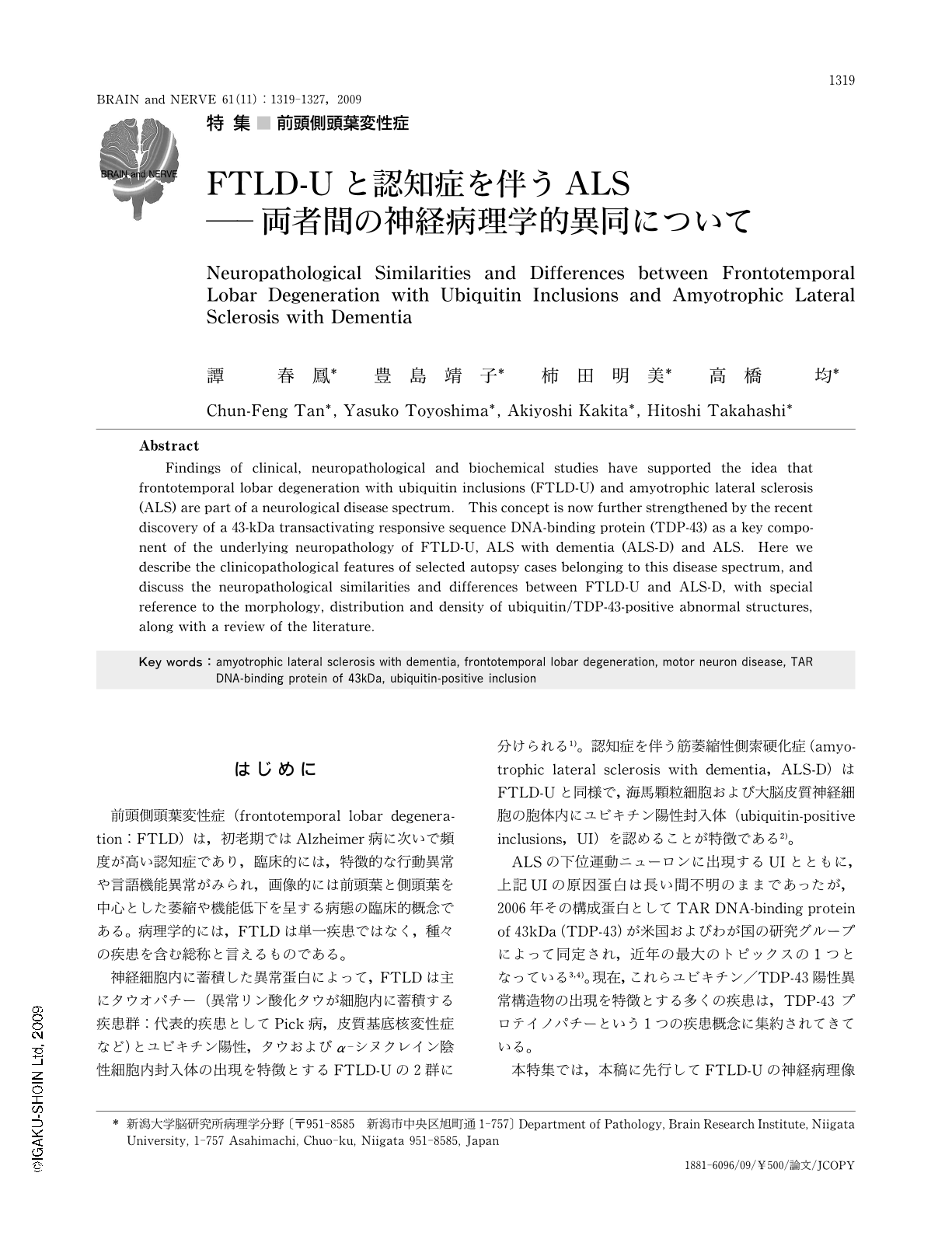Japanese
English
- 有料閲覧
- Abstract 文献概要
- 1ページ目 Look Inside
- 参考文献 Reference
はじめに
前頭側頭葉変性症(frontotemporal lobar degeneration:FTLD)は,初老期ではAlzheimer病に次いで頻度が高い認知症であり,臨床的には,特徴的な行動異常や言語機能異常がみられ,画像的には前頭葉と側頭葉を中心とした萎縮や機能低下を呈する病態の臨床的概念である。病理学的には,FTLDは単一疾患ではなく,種々の疾患を含む総称と言えるものである。
神経細胞内に蓄積した異常蛋白によって,FTLDは主にタウオパチー(異常リン酸化タウが細胞内に蓄積する疾患群:代表的疾患としてPick病,皮質基底核変性症など)とユビキチン陽性,タウおよびα-シヌクレイン陰性細胞内封入体の出現を特徴とするFTLD-Uの2群に分けられる1)。認知症を伴う筋萎縮性側索硬化症(amyotrophic lateral sclerosis with dementia,ALS-D)はFTLD-Uと同様で,海馬顆粒細胞および大脳皮質神経細胞の胞体内にユビキチン陽性封入体(ubiquitin-positive inclusions,UI)を認めることが特徴である2)。
ALSの下位運動ニューロンに出現するUIとともに,上記UIの原因蛋白は長い間不明のままであったが,2006年その構成蛋白としてTAR DNA-binding protein of 43kDa(TDP-43)が米国およびわが国の研究グループによって同定され,近年の最大のトピックスの1つとなっている3,4)。現在,これらユビキチン/TDP-43陽性異常構造物の出現を特徴とする多くの疾患は,TDP-43 プロテイノパチーという1つの疾患概念に集約されてきている。
本特集では,本稿に先行してFTLD-Uの神経病理像の詳細が記述されているので,ここではまず,その基本的な病理所見のみの記載とともに,当教室で経験したFTLD-U症例の臨床病理像(TDP-43の病理像を含む)を呈示する。次に,ALS-Dの疾患概念の確立から臨床病理像までを総説し,最後にFTLD-UとALS-Dの神経病理学的異同を概説する。なお,FTLD-Uという疾患概念は,本来広く運動ニューロン疾患を伴うものと伴わないものを含有するが,本稿では,FTLD-Uは運動ニューロン疾患を伴わないそれのみを指すこととする。
Abstract
Findings of clinical,neuropathological and biochemical studies have supported the idea that frontotemporal lobar degeneration with ubiquitin inclusions (FTLD-U) and amyotrophic lateral sclerosis (ALS) are part of a neurological disease spectrum. This concept is now further strengthened by the recent discovery of a 43-kDa transactivating responsive sequence DNA-binding protein (TDP-43) as a key component of the underlying neuropathology of FTLD-U,ALS with dementia (ALS-D) and ALS. Here we describe the clinicopathological features of selected autopsy cases belonging to this disease spectrum,and discuss the neuropathological similarities and differences between FTLD-U and ALS-D,with special reference to the morphology,distribution and density of ubiquitin/TDP-43-positive abnormal structures,along with a review of the literature.

Copyright © 2009, Igaku-Shoin Ltd. All rights reserved.


